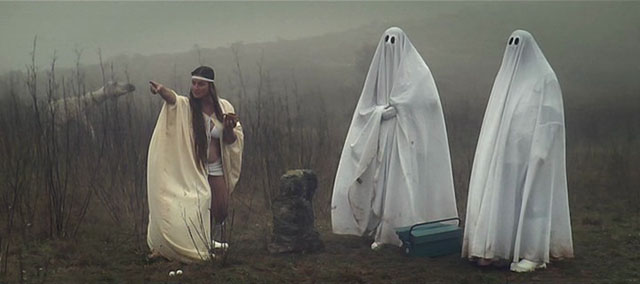
Whether it’s accidental or intentional, meaningful or just there for its own sake, weirdness is one of the reasons that make certain movies taste sweet, pleasantly sour, exotic, lasting or never-to-be-forgotten. Sergei Parajanov, David Lynch, Guy Maddin, Terry Gilliam, Andrzej Żuławski, Takashi Miike, Mamoru Oshii and Shinya Tsukamoto, amongst the others, could be certified as famous directors able to activate their audience’s weird-radar with great ease.
But, as the title suggests, this list is composed of lesser-known pieces by the authors who are not widely recognized (in most cases). In order to make it as diverse as possible, different genres, periods, countries and mediums (both live-action and animation) were taken into consideration. The entries’ order is chronological, which means it doesn’t necessarily reflect their quality.
1. Eggshells (Tobe Hooper, 1969) / USA
Weirdness of the hippy kind
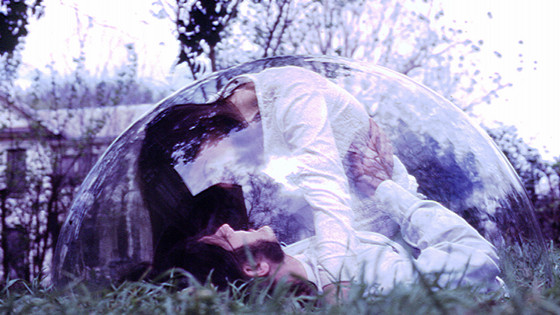
Prior to “fathering” one of the most iconic horror figures in cinema history, Tobe Hooper has created something quite different from the rest of his oeuvre.
Considered lost until 2009, his full-length debut was digitally restored and released in 2013, as a bonus on a blu ray edition of The Texas Chainsaw Massacre 2. Being an authentic representative of its era, it could be categorized as cinéma vérité hippy docu-drama with (debatable?) SF elements.
If there’s a story in Eggshells, it is about a “crypto-embryonic hyper-electric presence” (sic!), that manifests as a “half organic light bulb” in a basement of a small Austin commune’s house and plays with tripped out inmates’ minds.
A couple is preparing for the wedding, while occasionally discussing communism in a bathtub; their beat poet friend has a violent outburst toward his own car, and a young artists, seemingly unnoticeable by everyone, crosses swords with himself and finds true love in a balloon-infested grove.
Whatever Hooper’s intention was (aimless artistic self-indulgence or an attempt at portraying the fragility of reality), his film provides a great lesson on (hectic) editing, bringing the abundance of brilliantly framed shots. He demonstrates a keen sense for the sequences’ rhythm, exploring the hand-held camera possibilities.
Grainy images ennoble the most mundane scenes in the same way the exotic instruments complement a groovy atmosphere of dreaming under the plexiglass bubble.
2. The Death of Maria Malibran (Werner Schroeter, 1972) / West Germany
Weirdness of the avant-garde kind
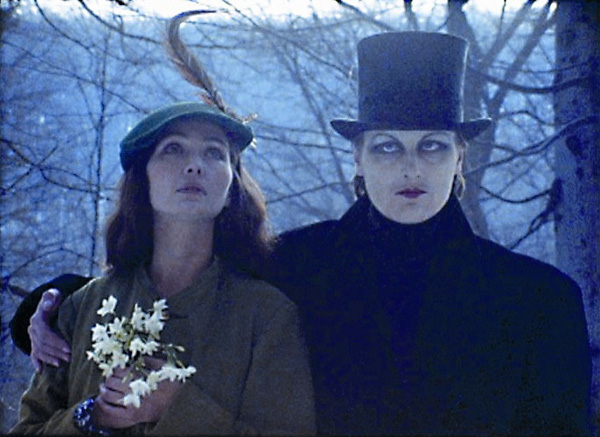
Mezzo-soprano Maria Malibran (1808-1836) was one of the most renowned opera singers from the early XIX century. Contemporaries describe her as a temperamental girl, whose dramatically intense performances earned her the admiration of many composers of the time.
A restless daughter of a celebrated tenor Manuel García, she personified the spirit of Romanticism and served as an inspiration for modern day divas, Maria Callas and Cecilia Bartoli. Her untimely death was the result of a horse riding accident.
Out of great love, Werner Schroeter perpetuated her in a film which could be regarded as a companion piece to his equally strange debut Eika Katappa. The Death of Maria Malibran (Der Tod der Maria Malibran) is not a biopic, but rather a flamboyant collage of emotional, strikingly beautiful tableaux vivants that act as campy postcards.
Portraying fatal passion, dolorous yearning, delirious fervor or cold indifference, Schroeter brings together the art of the early Renaissance, Baroque and Pre-Raphaelites, fairy-tales and ancient myths, Shakespearean soliloquies, fashion photography and avant-garde theatre.
Beside classical music, he weaves the threads of pop, jazz, cabaret and country into the sonic tapestry, pointing at his sense of self-irony. Intentionally off lip-sync (of many actresses that take turns at the character of so-called La Malibran) creates the mood of “umlauted” bel canto dream.
3. I Will Walk Like a Crazy Horse (Fernando Arrabal, 1973) / France
Weirdness of the satirical kind
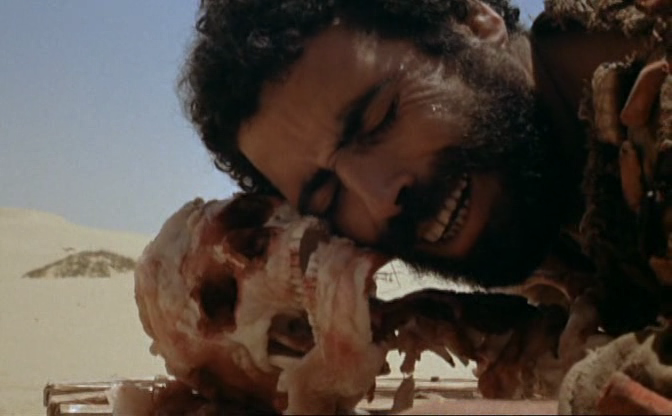
In his sophomore feature, Fernando Arrabal merges together (a sort of) bromance and satire on modern society into a dizzying, misanthropically intoned adventure, at the same time sublimely beautiful and revolting as hell. His “panic surrealism” spares absolutely no one and the result of a bold experimentation is an uncompromising and brutally honest film.
A cynical story focuses on firstly platonic, and later spiritual love between a runaway bon vivant Aden Ray and enigmatic hermit Marvel, whose powers include turning the night into the day and vice-versa. It is an incessant tirade about a hypocrisy of “civilized” people, who epitomize aggression, fanaticism, pollution, intolerance and exploitation.
Arrabal’s profane sermon consists of metaphorical and often fetishistic imagery, that tear down many taboos, shocking and provoking the viewer. Nothing can prepare you for the creative, profound and all-consuming madness of bizarre fantasies and disturbing episodes from Aden’s deranged life (not to mention a visceral epilogue).
4. Desires (Rafael Corkidi, 1977) / Mexico
Weirdness of the Jodorowsky-esque kind
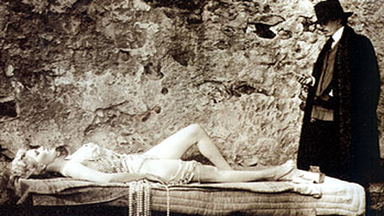
Have you seen the complete Jodorowsky’s opus? If your answer is “yes”, than you’re probably looking for something like his DP Rafael Corkidi’s last film shot on 35mm. Experimental melodrama Desires (Deseos) is a loose adaptation of Agustín Yáñez Delgadillo’s novel The Edge of the Storm (Al filo del agua).
Censored for seven years, and forgotten today, it appears as a torn episode of a soap-opera, whose “intestines” are connected by the barbed wire of eroticism, religious references and esoteric symbols.
Following the non-sequitur prelude and an announcement by the Four Horseman of the Apocalypse is a fragmented narrative about the fall of Timoteo Limón’s family, featuring Virgin Mary’s performance under the Noah’s Ark leftovers. It’s hard to put into words, let alone understand all of the details of this idiosyncratic portrait of sins, amorous reveries and human hypocrisy.
Flirting with the poetry of the absurd and finding inspiration in the art of surrealism, Corkidi molds an iconoclastic phantasmagoria that periodically transforms into an avant-garde musical. Impressive “ruin porn” sets serve as the enhancers of the film’s otherness.
5. The Medusa Raft (Karpo Aćimović-Godina, 1980) / Yugoslavia
Weirdness of the YU-Dada kind
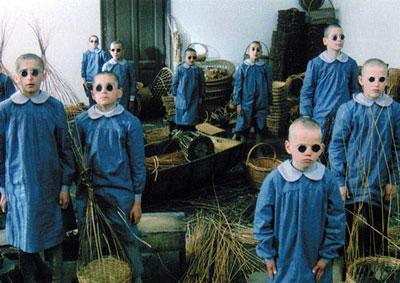
The Medusa Raft (Splav meduze) is certainly one of the most distinctive, attractive and cultivated Yugoslavian films (and the tamer predecessor of Mladen Đorđević’s The Life and Death of a Porno Gang).
Subtly provoking and sophisticatedly decadent, this “soppy comedy” follows a failed cultural revolution, borrowing its title from Théodore Géricault’s painting. In the aftermath of frigate Méduse’s wreckage, Godina sees YU-society’s tragedy, which is constantly repeating itself while leaving only the echo of lost generations’ shriek.
Set in the 20s of the last century, a twisted tale of the travelling troupe of “zenithists” is sliced into tiny pieces – sweet, bitter, sour or hot, sometimes all together, but always infinitely delicious. The screenplay by Branko Vučićević (Makavejev’s cooperator on Love Affair, or the Case of the Missing Switchboard Operator) is authentic, in spite of quoting Croatian Dada poetry, and it brings likeable characters with a doomed mission.
Suggestive thespian ensemble breathes life into those young idealists with great believability and grace, whereby Godina’s helming is assured and precise, with his raft floating against the waves. We also learn that it is “healthy to drink electric milk”.
6. Electric Angel (Thanasis Rentzis, 1981) / Greece
Weirdness of the amorous kind

Electric Angel (Ilektrikos angelos) is a funky, Dadaist kaleidoscope of wild imagery and intoxicating cacophony of sounds, that describes affection between fictitious cosmic phenomena, gods and goddesses, man and woman, hand and genitalia, mother and child, old woman and her cats, the sky and bare treetop.
Bizarreness, Impudence and Phantasmagoria are its first, middle and last name. It feels like watching Gilliam’s animations for Monty Python’s Flying Circus and documentary of architecture and kitsch art, while Dušan Makavejev, disguised as florist, arranges artificial bouquets and sings distracting renaissance madrigals during the downpour of old, hand-tinted photos…
At times, one gets the impression that Rentzis parodies romance, or rather its idealized version from romantic movies, giving himself a full artistic freedom. He’s like an unstoppable anarchist, whose chaos inspires, or a six-handed dream-weaver, who draws you into the web of perverse hallucinations.
His experiment would have been even more successful, if it had been a few vignettes shorter. Nevertheless, it is quite interesting as it is, twisted and absurd, suitable for wall projections at some postmodernist installations exhibition. Only for the bold and adventurous, who prefer their Eros silly.